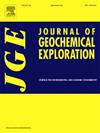中非铜带Cu-Co硫化物的LA-ICP-MS元素分析:对金属迁移和再分配的影响
IF 3.3
2区 地球科学
Q1 GEOCHEMISTRY & GEOPHYSICS
引用次数: 0
摘要
本研究涉及Tenke Fungurume矿区(TFMD)、刚果铜带Kamoto和Luiswishi矿床以及赞比亚铜带Nkana矿床硫化物的地球化学分析。目的是更好地了解这些矿床中的成矿过程和金属的分布。铁矿和黄铜矿的微量元素含量表明,在中非铜带(CACB)的不同地点,矿石流体的金属含量不同。这种可变性可能反映了局部的矿石流体来源和每个矿床的分离成矿系统,而不是单一的、均匀的全盆地流体储层。Carrollite的Co/Cu比值从刚果铜带中部,即从Luiswishi到TFMD,再到西部的Kamoto,呈下降趋势。在每个矿床中,卡罗石的微量元素含量在不同共生阶段表现出最小的变化,表明在随后的成矿阶段成岩硫化物的再平衡。黄铜矿的微量元素组成进一步证实了这一点,黄铜矿在主要成矿阶段表现出一致的模式。然而,在TFMD,顺褶皱脉中的黄铜矿与褶皱前和褶皱后脉中的黄铜矿明显不同,表明在单个矿床中存在单独的矿化阶段。TFMD褶皱后阶段黄铜矿中锗(Ge)含量异常高(av = 273 ppm,最高可达772 ppm),可能与一次重要的造山后成矿事件有关,该事件导致了刚果铜带Cu-Zn-Pb (Ge, Ag) Kipushi矿床的形成。本文章由计算机程序翻译,如有差异,请以英文原文为准。

LA-ICP-MS element analysis of Cu–Co sulfides from the Central African Copperbelt: implications for the mobility and redistribution of metals
This study involves the geochemical analysis of sulfides from the Tenke Fungurume mining district (TFMD), Kamoto and Luiswishi deposits in the Congolese Copperbelt and the Nkana deposit in the Zambian Copperbelt. The objective is to better understand the ore-forming processes and the distribution of metals within these deposits. The trace element contents of carrollite and chalcopyrite suggest that ore fluids varied in metal contents across different locations within the Central African Copperbelt (CACB). This variability likely reflects localized ore fluid sources and separated mineralizing systems for each deposit, rather than a single, homogenized basin-wide fluid reservoir. Carrollite displays a trend of decreasing Co/Cu ratios from the central part of the Congolese Copperbelt, i.e. from Luiswishi through TFMD to Kamoto in the western part. Within each deposit, the trace element content of carrollite exhibits minimal variations across different paragenetic phases, indicating the re-equilibration of the diagenetic sulfides during the subsequent mineralization phases. This is further corroborated by the trace element composition of chalcopyrite, which exhibits consistent patterns across the main mineralization phases. However, at TFMD, chalcopyrite from the syn-folding vein differs notably from that in the pre-folding and post-folding veins, suggesting the presence of separate mineralizing phases within a single deposit. The exceptionally high germanium (Ge) content (av. = 273 ppm, up to 772 ppm) in chalcopyrite from the post-folding stage at TFMD may be linked to a significant post-orogenic mineralization event that led to the formation of the Cu-Zn-Pb (Ge, Ag) Kipushi deposit in the Congolese Copperbelt.
求助全文
通过发布文献求助,成功后即可免费获取论文全文。
去求助
来源期刊

Journal of Geochemical Exploration
地学-地球化学与地球物理
CiteScore
7.40
自引率
7.70%
发文量
148
审稿时长
8.1 months
期刊介绍:
Journal of Geochemical Exploration is mostly dedicated to publication of original studies in exploration and environmental geochemistry and related topics.
Contributions considered of prevalent interest for the journal include researches based on the application of innovative methods to:
define the genesis and the evolution of mineral deposits including transfer of elements in large-scale mineralized areas.
analyze complex systems at the boundaries between bio-geochemistry, metal transport and mineral accumulation.
evaluate effects of historical mining activities on the surface environment.
trace pollutant sources and define their fate and transport models in the near-surface and surface environments involving solid, fluid and aerial matrices.
assess and quantify natural and technogenic radioactivity in the environment.
determine geochemical anomalies and set baseline reference values using compositional data analysis, multivariate statistics and geo-spatial analysis.
assess the impacts of anthropogenic contamination on ecosystems and human health at local and regional scale to prioritize and classify risks through deterministic and stochastic approaches.
Papers dedicated to the presentation of newly developed methods in analytical geochemistry to be applied in the field or in laboratory are also within the topics of interest for the journal.
 求助内容:
求助内容: 应助结果提醒方式:
应助结果提醒方式:


